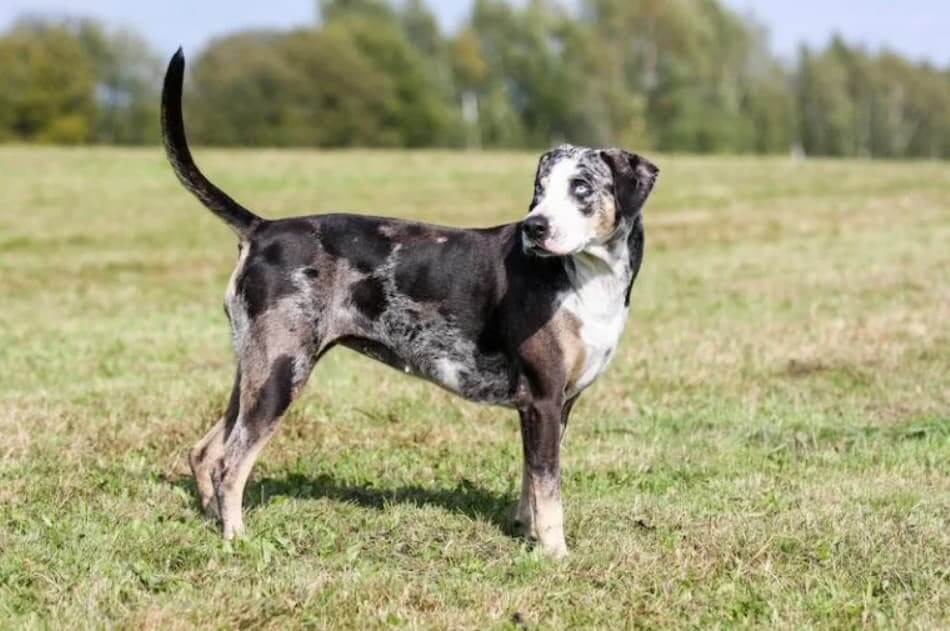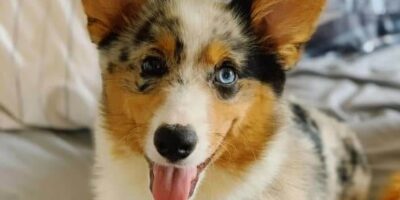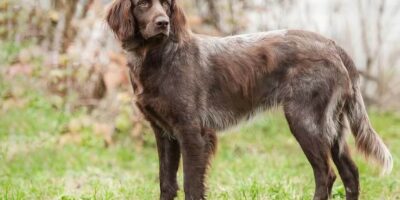The American Leopard Hound should be under the gaze of at least a thoughtful eye for the dog lover in you. Whomever’s hand it falls into, there’s no sign that this isn’t a purebred from the very start.
As you might have noticed or heard, it can be startlingly fast and agile. But this makes it unique as much as anything else because it is also surprisingly sensitive and quiet in so many ways. To learn more about this dog, read this article.
What is an American leopard?
The American Leopard Hound is a breed of dog that was developed in the United States, following a lineage of other leopard hound breeds. In fact, the name “leopard hound” refers to dogs with spots on their coats and little resemblance to actual leopards.
The American Leopard Hound is part Labrador Retriever, which means it has fewer of those pesky limits on activity and will happily accompany you on walks through the forest or along the shore—whether you want it to! It has some Greyhound in its DNA as well, which explains its smooth gait and high-energy attitude.
A touch of Beagle gives it an excellent sense of smell; throw in Weimaraner for good measure, and you have yourself one great tracking dog! Finally, comes the Airedale Terrier, which contributes lots of energy and stamina to this sporty dog’s personality.
History
- Leopard hounds have been man’s best friend since their introduction to Egypt in the first half of the 20th century. They were bred as a hunting companion and guard dog and were an integral part of every great pharaoh’s army, family, and home.
- The Hound (as they’re called) had a short coat that protected them from the sun but didn’t retain much water in the desert climate, making it easier for them to regulate their body temperatures and survive in extreme conditions.
- They are one of the few dogs that can survive long periods without water or food, allowing them to be used on long treks or even work as pack animals for ancient nomads who carried their supplies for miles across unforgiving terrain.
Is an American Leopard a good family dog?
American Leopard Hounds are a medium-to-large sized, short-haired breed of dog, and make excellent pets for families. The American Leopard Hound is loyal and loving towards its family, but can be timid around strangers.
They can be aggressive with other dogs if not properly socialized from a young age. They are exceptional with children and tend to do well in households with cats or other small animals. Furthermore, they require moderate exercise and grooming needs.
Breed Characteristics
The American Leopard Hound was bred to hunt raccoons, but it also hunts rabbits. This dog has a shiny, short coat and a long tail that curls and uncurls as the dog moves around. Its legs are long and muscular.
The American Leopard Hound’s head is broad and flat, which helps it sense its surroundings when hunting an animal. Its large, dark eyes are set on the sides of its head, so it can see an enemy coming from both directions. Medium-length drooping ears help with hearing prey above ground; long thick whiskers help it find prey in dark places underground.

Temperament
American Leopard Hounds are a breed that is nearly always described as even-tempered. They’re friendly with strangers, and they seem to enjoy the company of people more than they do other dogs.
What are some things that you should know about American Leopard Hounds?
- They’re playful and energetic—American Leopard Hounds had been used in circus acts because of their amiability toward humans and their willingness to perform tasks on command. These traits make them an excellent pet for homes with children;
- They don’t bark much—American Leopard Hounds were bred to hunt silently in order not to spook prey. So if you want a dog who will alert you to the mailman’s arrival, look elsewhere;
- They do get along well with other dogs—They have plenty of energy, but this energy can easily be channeled into playtime with other pups instead of causing trouble around your house or property.
Adaptability
American leopard hounds are great dogs for people who live in the country. They love being outdoors, and they tend to be very social, meaning they want to hang out with their owner.
While they can live in an apartment or condo, they do best when they have a yard to run around in. If you don’t have a yard, consider getting a dog that doesn’t need as much running time. The American leopard is also relatively active indoors and does best when he has a family member present most of the time.
Health
While the American Leopard Hound is generally a healthy dog, they may be prone to certain diseases and disorders—just like people, no breed or individual is immune to all illnesses.
One of the most common problems in all dogs, including the American Leopard Hounds, is obesity. As with humans, pets should maintain a healthy weight through regular exercise and diet control. Obesity in dogs can lead to arthritis and other joint issues, as well as general discomfort and reduced quality of life.
The most commonly diagnosed health issues among American Leopard Hounds include hip dysplasia — a condition caused by malformed hip joints — as well as progressive retinal atrophy (PRA), which causes gradual loss of vision related to mutations in the retina’s photoreceptor cells.
Although there are tests available for DCM screening for both young hounds and older dogs who have no history of heart failure symptoms. It’s still important to watch out for symptoms like coughing or wheezing whenever exercising or experiencing any stressful situations.
Grooming Needs
To give you a sense of what’s involved, here are some basic grooming needs:
- Don’t brush them too much. The American Leopard Hound has soft, sleek fur that is easy to maintain and doesn’t need to be brushed often. Brush them only twice a week to avoid tangling the hair.
- Only bathe when necessary. Their coat is naturally water-resistant, so unless they’re covered in mud or dirt when you get home from work, don’t go for the full bath treatment every other day.
- Instead, simply wipe off any excess dirt on your pup with a damp rag during their evening walk before heading inside.
- Be careful with their ears and eyes. Cleaning out their ears should be done only if there’s an issue—otherwise, just wait until their annual vet appointment (we go to the Banfield Pet Hospital) to have this done by professionals. Their eyes aren’t 100% tear-proof until about age two and may require some help to get rid of gunk if it builds up overnight; otherwise, keep an eye on them until they take care of themselves!
Trainability
The American Leopard Hound has a reputation for being one of the smartest hounds around, due in part to its ability to be trained easily. However, they also have strong instincts that need to be tamed with proper training and attention.
You must spend ample time training your pup from an early age, so he grows up understanding how to behave in the presence of people and other animals.
Most importantly, remember that positive reinforcement is best for getting your American Leopard Hound to do what you want without negative behavior such as chewing or digging.
Physical Needs
With a sturdy, muscular build and long, thick fur, the American leopard hound is a beautiful dog that demands attention. However, it’s not all looks with this breed: as a member of the Scenthound group, the American leopard hound has one of the most impressive noses around.
It won’t do well if you don’t provide regular mental stimulation—think agility training or even puppy kindergarten classes—to keep its mind sharp. The more involved you are with its training, the more faithful it will be in returning your devotion when called upon later in life. The breed has an independent streak that allows it to roam great distances when given proper outlets for its energy (i.e., daily exercise).
Even if you live in an apartment building on a busy city street, remember that this dog loves to spend time outdoors so much that it makes up for any negative side effects of living in congested areas by being extra adaptable regarding sheer exuberance and liveliness while being outside!
Size and Weight
American Leopard Hounds are an offshoot of the Beagle family tree, bred to be hunters and companions for royalty. This breed was once owned by influential people like King Henry VIII, who kept them to hunt small game like rabbits. Born with a natural (and adorable) prey drive, these dogs are happiest when they can chase down balls and toys.
This breed is classified as a medium-sized dog, but this depends on if the dog is inside or outside. When outside, the dog weighs between 55-80 pounds, while the height of this breed ranges between 22-26 inches tall.
Personality
With their soft, silky coats and versatility when it comes to hunting and farm work, the American Leopard Hound was once a highly prized dog. The breed was used primarily by farmers to protect their livestock against predators.
Their friendly disposition makes them good with children, but they are also good family dogs who enjoy going on walks or car rides. However, the breed does need plenty of room to run for him to reach his full potential. So if you don’t have a large yard for your American Leopard Hound to play in, it’s best for them to be indoor-only pets.
Feeding
The American Leopard Hound has a very high metabolism and therefore needs to eat regularly. They also have a short digestive tract, which means they cannot eat a lot of food at one time.
They are considered an omnivore because they eat both meat and vegetables, although their diet should be primarily based on protein. It is good to give them some fruits, but they do not require carbohydrates in their diet as much as other dogs do.
How much is an American Leopard Hound?
Organizations like the AKC oversee their regional clubs and events, hotels allow dogs to come along with their owners, and individuals who live in cities with dog-friendly apartments can easily find roommates that won’t be put off by their new pet’s size. American Leopard Hound prices vary depending on what kind of breeder you’re working with.
Breeders who specialize in breeding an American Leopard Hound may charge more than those who just have one as a pet, but they’re also more likely to be experienced and knowledgeable when it comes to helping you train an American Leopard Hound puppy and ensuring that its behavior is appropriate for your local environment and lifestyle.
When looking at your options on where to buy an American Leopard Hound from, make sure you’re getting them from a reputable breeder—both for purposes of buying a healthy dog whose parent dogs have been put through rigorous health testing programs and being able to take advantage of any support networks in place should issues arise post-purchase.
Conclusion
It’s time to say goodbye. If you’ve made it this far, then I hope you’ve learned something new about the American Leopard Hound and maybe even thought about giving one a home if you don’t have one already. They’re extremely healthy and make great companions, though they may be a bit stubborn from time to time.
Be sure that your little horse has plenty of friends and exercise in his daily life as well. The ideal family for this breed is a moderately active group with an older child who can take on the role of pack leader. Good luck!


